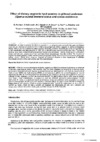Please use this identifier to cite or link to this item:
https://accedacris.ulpgc.es/jspui/handle/10553/76448
| DC Field | Value | Language |
|---|---|---|
| dc.contributor.author | Montero, D. | en_US |
| dc.contributor.author | Kalinowski, T. | en_US |
| dc.contributor.author | Caballero, M. J. | en_US |
| dc.contributor.author | Obach, A. | en_US |
| dc.contributor.author | Tort, L. | en_US |
| dc.contributor.author | Robaina, L. | en_US |
| dc.contributor.author | Izquierdo, M. S. | en_US |
| dc.date.accessioned | 2020-12-09T12:17:27Z | - |
| dc.date.available | 2020-12-09T12:17:27Z | - |
| dc.date.issued | 2005 | en_US |
| dc.identifier.issn | 1022-1379 | en_US |
| dc.identifier.uri | https://accedacris.ulpgc.es/handle/10553/76448 | - |
| dc.description.abstract | In order to evaluate the eftect of vegetable oils on gilthead seabream health, fish were fed difterent diets that were formulated substituting 60% of fish oil by soybean oil (60SO), rapeseed oil (60RO) or linseed oil (BOLO). 80% of fish oil substítutíon by either soybean oil (80SO) or linseed oil (BOLO) plus a mix of vegetable oils at 60% substitution were also assayed. A 100% fish oil diet (FO) was used as a control diet. After 7 months of feeding, basal levels of difterent immunological parameters were determinad. Besides, response to a confinement stress and fatty acid composition of liver and head kidney macrophages was also studied. The inclusion of soybean oil decreased both ACH50 and head kidney phagocytic activity. Rapeseed oíl decreased also phagocytic activity. Linseed altered stress response. Soybean oíl produced steatosis in liver hepatocytes. A selective incorporation of sorne EFAs such as DHA and ARA was observed. | en_US |
| dc.description.abstract | Afín d'évaluer l'effet des hui/es végétales sur la santé de la daurade roya/e, les poissons recevaient différents régimes qui étaient formulés en remplagant 60% de /'hui/e de poisson par de /'hui/e de soja (60SO), de /'hui/e de colza (60RO) ou de /'hui/e de fin (60LO). On a testé également un taux de subsNtution de 80% de /'hui/e de poisson par de /'hui/e de soja (80SO) ou de /'hui/e de /in (BOLO) en plus d'un mé/ange d'huiles végétales a un taux de substitution de 60%. Le régime témoin était a 100% hui/e de poisson (FO). Apres 7 mois d'alimentation, les niveaux de base des différents parametres immunologiques ont été déterminés. En outre, on a également étudié la réponse au stress de confinement et la composition en acides gras des macrophages du foie et du rein antérieur. L 'inclusion d'huile de soja a réduit l'ACH50 et l'activité de phagocytose du rein antérieur. L 'hui/e de colza a également réduit l'activité de phagocytose. Le fin a altéré la réponse au stress. L 'hui/e de soja a produit une stéatose des hépatocytes du foie. On a observé une incorporation sé/ective de certains acides gras essentiels tels que les DHA et les ARA. | en_US |
| dc.language | eng | en_US |
| dc.relation | RAFOA (Q5RS-2000-30058), Unión Europea | en_US |
| dc.relation.ispartof | Cahiers Options Mediterranéennes | en_US |
| dc.source | Cahiers Options Mediterranéennes [ISSN 1022-1379], v. 63, p. 103-112 | en_US |
| dc.subject | 310502 Piscicultura | en_US |
| dc.subject.other | Seabream | en_US |
| dc.subject.other | Fishoil | en_US |
| dc.subject.other | Vegetable oils | en_US |
| dc.subject.other | Stress resistance. | en_US |
| dc.title | Effect of dietary vegetable lipid sources in gilthead seabream (Sparus aurata) immune status and stress resistance | en_US |
| dc.title.alternative | Effet des sources alímentaires de lipides végétaux sur l'état immunitaire et la résistance au stress de la daurade royale (Sparus aurata) | en_US |
| dc.type | info:eu-repo/semantics/article | en_US |
| dc.type | Article | en_US |
| dc.description.lastpage | 112 | en_US |
| dc.description.firstpage | 103 | en_US |
| dc.relation.volume | 63 | en_US |
| dc.investigacion | Ciencias | en_US |
| dc.type2 | Artículo | en_US |
| dc.description.numberofpages | 10 | en_US |
| dc.identifier.ulpgc | Sí | en_US |
| dc.contributor.buulpgc | BU-BAS | en_US |
| item.grantfulltext | open | - |
| item.fulltext | Con texto completo | - |
| crisitem.author.dept | GIR Grupo de Investigación en Acuicultura | - |
| crisitem.author.dept | IU de Investigación en Acuicultura Sostenible y Ec | - |
| crisitem.author.dept | Departamento de Biología | - |
| crisitem.author.dept | GIR IUSA-ONEHEALTH 3: Histología y Patología Veterinaria y Forense (Terrestre y Marina) | - |
| crisitem.author.dept | IU de Sanidad Animal y Seguridad Alimentaria | - |
| crisitem.author.dept | Departamento de Morfología | - |
| crisitem.author.dept | GIR Grupo de Investigación en Acuicultura | - |
| crisitem.author.dept | IU de Investigación en Acuicultura Sostenible y Ec | - |
| crisitem.author.dept | Departamento de Biología | - |
| crisitem.author.dept | GIR Grupo de Investigación en Acuicultura | - |
| crisitem.author.dept | IU de Investigación en Acuicultura Sostenible y Ec | - |
| crisitem.author.dept | Departamento de Biología | - |
| crisitem.author.orcid | 0000-0002-4358-2157 | - |
| crisitem.author.orcid | 0000-0002-2575-0997 | - |
| crisitem.author.orcid | 0000-0003-4857-6693 | - |
| crisitem.author.orcid | 0000-0003-4297-210X | - |
| crisitem.author.parentorg | IU de Investigación en Acuicultura Sostenible y Ec | - |
| crisitem.author.parentorg | IU de Sanidad Animal y Seguridad Alimentaria | - |
| crisitem.author.parentorg | IU de Investigación en Acuicultura Sostenible y Ec | - |
| crisitem.author.parentorg | IU de Investigación en Acuicultura Sostenible y Ec | - |
| crisitem.author.fullName | Montero Vítores, Daniel | - |
| crisitem.author.fullName | Caballero Cansino, María José | - |
| crisitem.author.fullName | Robaina Robaina, Lidia Esther | - |
| crisitem.author.fullName | Izquierdo López, María Soledad | - |
| Appears in Collections: | Artículos | |
Page view(s)
77
checked on Dec 16, 2023
Download(s)
38
checked on Dec 16, 2023
Google ScholarTM
Check
Share
Export metadata
Items in accedaCRIS are protected by copyright, with all rights reserved, unless otherwise indicated.
